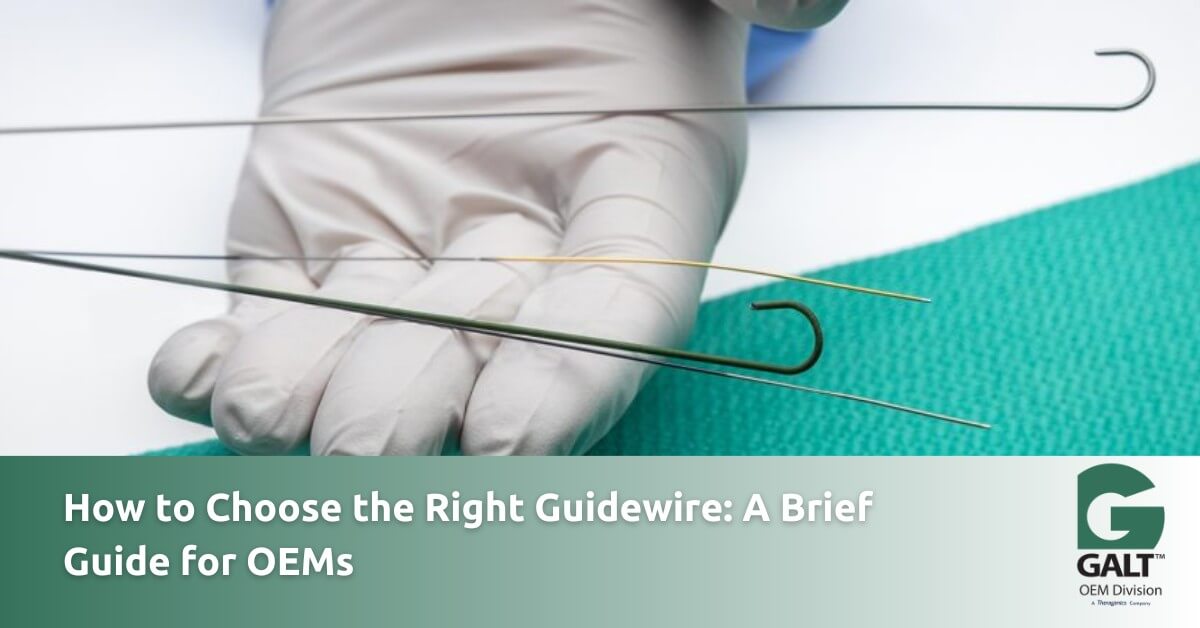How to Choose the Right Guidewire for Your Medical Device Product Range

Guidewires are essential components for a range of minimally invasive medical procedures where it is necessary to navigate highly complex vasculatures and tortuous anatomies. They help medical practitioners reach diagnostic and treatment sites and are used to position and stabilize catheters and stents, as well as for the placement of interventional devices. If guidewires are a crucial component in your medical device product range, how do you choose the right option?
Components, features, and performance characteristics can vary significantly from guidewire to guidewire. This blog will give you an overview of what to look for when choosing a guidewire.
Performance Characteristics of Guidewires
Guidewires can have a range of performance characteristics that make them suitable for different types of minimally invasive medical procedures. Those performance characteristics include:
- Push control – the ability to push the guidewire through the body’s vasculature.
- Steerability – the ability to steer the guidewire through vessels.
- Trackability – the combined push control and steerability of the guidewire is often referred to as trackability.
- Stability or rail support – how stable the guidewire is during equipment exchange, such as the placement of catheters.
- Torque control – the rotational capabilities of the guidewire, i.e. where rotation applied by the medical practitioner at the proximal end of the guidewire translates to the same amount of rotation at the distil tip. Turn-for-turn torque response is typically required.
- Flexibility – the ability of the guidewire to flex on its longitudinal axis.
- Opacity or radiopacity – the visibility of the guidewire to the medical team while it is in the patient’s body.
- Tactile feel – how usable the guidewire is for the medical practitioner.
- Flexibility – high levels of flexibility make the guidewire easier to navigate while stiffness provides greater support for other components such as catheters.
- Crossing ability and tip load – crossing ability refers to how well the guidewire can get past obstructions such as stenosed lesions and calcium deposits on the way to the target location. It’s also important the guidewire supports other components, such as catheters, as they cross obstructions. Tip load is the amount of force required to pass obstructions.
Components and Features of Guidewires
Tip Configuration
Common tip configurations include J-curve, angled, and straight. Guidewire tips can also have varying levels of rigidity, i.e., can the tip change shape, and how much force is required to change the tip’s shape? J-tips and angled tips can have various configurations, while tip shape retention is an important feature in some situations.
Core Taper
The length of the core as it tapers to the tip.
Lubricity
Lubricity reduces friction while the guidewire navigates through the body without compromising usability for the medical practitioner. Guidewires can typically be supplied with or without coatings that increase lubricity.
Materials
Materials used in guidewires must be biocompatible. Common materials include:
- Nitinol – for flexibility and kink resistance.
- Stainless steel – for torque control.
- Gold – for corrosion and wear resistance as well as being highly visible when inside the body.
- Platinum – similar to gold, platinum is corrosion-resistant and radiopaque.
Braiding and Coiling
The outer coil or braid layer added to guidewires to improve certain performance characteristics such as shape retention or flexibility.
Size
The length of the guidewire and its outer diameter.
Radiopaque Markings
Markings on the guidewire to make it visible to the medical practitioner while inside the patient’s body, often using a fluoroscopy machine.
Transition
The smoothness of the transition between the guidewire’s tip and core.
Partner With a Supplier You Can Depend On
Whatever components, features, and performance characteristics you choose, it is important you select a supplier with an established reputation, a track record of success, and a wide enough range to fully accommodate your requirements. It is also important your guidewire supplier delivers high standards of service, including meeting shipping deadlines. At Galt, we supply guidewires to OEMs in North America and around the world. To discuss your requirements, get in touch.
.
.
